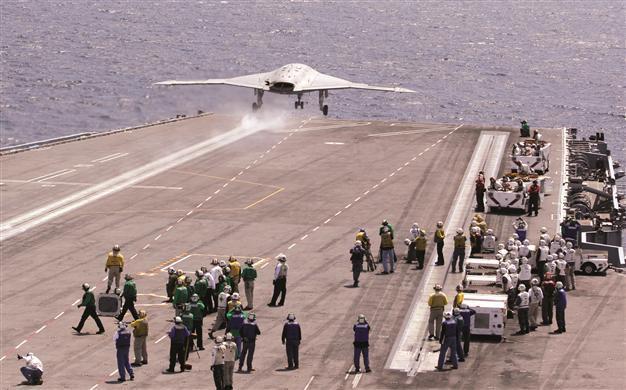US drone makes historic landing on carrier deck
ABOARD USS GEORGE H.W. BUSH

A X47-B Navy drone is launched off the deck of the nuclear aircraft carrier USS George H. W. Bush. AP photo
A bat-winged drone touched down smoothly on the deck of a U.S. aircraft carrier on July 10, marking a historic milestone for robotic flight.
The U.S. Navy’s X-47B floated down toward the carrier USS George H.W. Bush at reduced speed and then caught an arresting wire on its tail hook, bringing it to a stop in a textbook landing, as reporters and top brass watched. “You saw the future today,” Navy Secretary Ray Mabus told journalists afterward.
The experimental plane had taken off about an hour earlier from the Patuxent River naval air station in Maryland before arriving at the carrier off the Virginia coast, Agence France-Presse reported.
Naval pilots require years of training to learn how to land a fighter jet on a carrier floating at sea, one of the most daunting tasks in aviation. But July 10’s unprecedented landing by an unmanned plane showed that sophisticated computer software could perform the same task, guiding a robotic aircraft safely onto the deck of a ship at sea.
The touch down by the unmanned plane, dubbed “salty dog” by the Navy, represented a new era in naval flight, 102 years since a bi-plane made the first arrested landing on a ship.
Escorted by two F-18 fighter jets, the grey X-47B was perfectly aligned with the carrier deck as it made its descent, readjusting its position automatically with a GPS navigational system installed in the aircraft and on the carrier below.
In contrast to older model drones such as the Predator and Reaper, the X-47B can fly with more autonomy and does not require flight operators to exert constant step-by-step direction using a joystick. In July 10’s test, the plane calculated on its own when to put its wheels down.
Rear Admiral Mat Winter, head of the Navy ‘s unmanned aviation program, called it an event for the “history books,” but said the successful outcome came as no surprise after years of research and testing.
